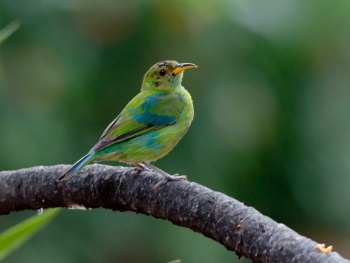(variation) |
(Add photo) |
||
| Line 17: | Line 17: | ||
====Subspecies==== | ====Subspecies==== | ||
[[Image:967 Honeycreeper, Green 01b Chlorophanes spiza HONDURAS.jpg|thumb|350px|right|Male Subspecies ''guatemalensis''<br />Photo © by {{user|peterday|peterday}}<br />Pico Bonito Lodge [[Honduras]], March 2016]] | [[Image:967 Honeycreeper, Green 01b Chlorophanes spiza HONDURAS.jpg|thumb|350px|right|Male Subspecies ''guatemalensis''<br />Photo © by {{user|peterday|peterday}}<br />Pico Bonito Lodge [[Honduras]], March 2016]] | ||
| + | [[Image:2449 Honeycreeper, Green (m).jpg|thumb|350px|right|Male Subspecies ''spiza''<br />Photo © by {{user|peterday|peterday}}<br />Asa Wright Nature Centre [[Trinidad]], March 2024]] | ||
There are 7 subspecies<sup>[[#References|[1]]]</sup>: | There are 7 subspecies<sup>[[#References|[1]]]</sup>: | ||
*''C. s. guatemalensis'': | *''C. s. guatemalensis'': | ||
Latest revision as of 21:29, 9 April 2024

Photo © by Dave B Smith
Asa Wright, Trinidad
Note: this image exaggerates the blue in the plumage of the male, look at other images in the gallery by following the link at the end of this entry
- Chlorophanes spiza
Description
Male is overall blue-green with a black hood which covers the crown and the auriculars and goes down into a tip on the side of the neck. Bill is slender and decurved, yellow except for the upper half of upper mandible, which is black. Eye is red in adult, reddish-brown in the immature which otherwise looks like a female.
Female is overall green with the bill imitating the bill of the male. Throat can be contrasting yellow in immature birds.
Both sexes have gray legs.
Variation
Males of subspecies subtropicalis and caerulescens are a darker blue than the other subspecies.
Distribution
Green Honeycreeper is found from Mexico through Central America and South America to Ecuador, Peru, and Bolivia, and east through Venezuela and the Guianas to eastern Brazil; also in Trinidad.
Taxonomy
Honeycrepers are grouped with Tanagers.
Subspecies
There are 7 subspecies[1]:
- C. s. guatemalensis:
- C. s. arguta:
- Extreme eastern Honduras to north-western Colombia
- C. s. exsul:
- C. s. subtropicalis:
- Andes of Colombia and western Venezuela
- C. s. caerulescens:
- South-eastern Colombia to eastern Ecuador, eastern Peru and western Bolivia
- C. s. spiza:
- C. s. axillaris:
- Coastal eastern Brazil (Pernambuco to Santa Catarina)
Habitat
Humid forest, mainly in the canopy
Behavior
Diet
Eats fruits, a little nectar and the occasional insect. Will also frequent fruit feeders as for example Asa Wright in Trinidad.
References
- Clements, J. F., T. S. Schulenberg, M. J. Iliff, D. Roberson, T. A. Fredericks, B. L. Sullivan, and C. L. Wood. 2015. The eBird/Clements checklist of birds of the world: v2015, with updates to August 2015. Downloaded from http://www.birds.cornell.edu/clementschecklist/download/
Recommended Citation
- BirdForum Opus contributors. (2024) Green Honeycreeper. In: BirdForum, the forum for wild birds and birding. Retrieved 22 December 2024 from https://www.birdforum.net/opus/Green_Honeycreeper
External Links
GSearch checked for 2020 platform.1






